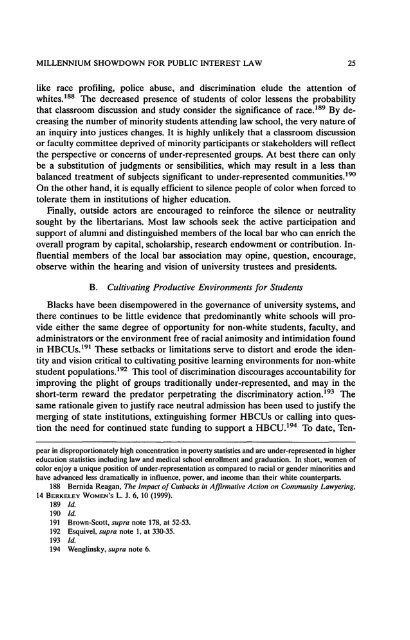Download Electronic Version - UDC Law Review
Download Electronic Version - UDC Law Review
Download Electronic Version - UDC Law Review
You also want an ePaper? Increase the reach of your titles
YUMPU automatically turns print PDFs into web optimized ePapers that Google loves.
MILLENNIUM SHOWDOWN FOR PUBLIC INTEREST LAW 25<br />
like race profiling, police abuse, and discrimination elude the attention of<br />
whites. 188 The decreased presence of students of color lessens the probability<br />
that classroom discussion and study consider the significance of race. 189 By decreasing<br />
the number of minority students attending law school, the very nature of<br />
an inquiry into justices changes. It is highly unlikely that a classroom discussion<br />
or faculty committee deprived of minority participants or stakeholders will reflect<br />
the perspective or concerns of under-represented groups. At best there can only<br />
be a substitution of judgments or sensibilities, which may result in a less than<br />
balanced treatment of subjects significant to under-represented communities. 190<br />
On the other hand, it is equally efficient to silence people of color when forced to<br />
tolerate them in institutions of higher education.<br />
Finally, outside actors are encouraged to reinforce the silence or neutrality<br />
sought by the libertarians. Most law schools seek the active participation and<br />
support of alumni and distinguished members of the local bar who can enrich the<br />
overall program by capital, scholarship, research endowment or contribution. Influential<br />
members of the local bar association may opine, question, encourage,<br />
observe within the hearing and vision of university trustees and presidents.<br />
B. Cultivating Productive Environments for Students<br />
Blacks have been disempowered in the governance of university systems, and<br />
there continues to be little evidence that predominantly white schools will provide<br />
either the same degree of opportunity for non-white students, faculty, and<br />
administrators or the environment free of racial animosity and intimidation found<br />
in HBCUS. 191 These setbacks or limitations serve to distort and erode the identity<br />
and vision critical to cultivating positive learning environments for non-white<br />
student populations. 192 This tool of discrimination discourages accountability for<br />
improving the plight of groups traditionally under-represented, and may in the<br />
short-term reward the predator perpetrating the discriminatory action. 193 The<br />
same rationale given to justify race neutral admission has been used to justify the<br />
merging of state institutions, extinguishing former HBCUs or calling into question<br />
the need for continued state funding to support a HBCU}94 To date, Tenpear<br />
in disproportionately high concentration in poverty statistics and are under-represented in higher<br />
education statistics including law and medical school enrollment and graduation. In short, women of<br />
color enjoy a unique position of under-representation as compared to racial or gender minorities and<br />
have advanced less dramatically in influence, power, and income than their white counterparts.<br />
188 Bemida Reagan, The Impact of Cutbacks in Affirmative Action on Community <strong>Law</strong>yering,<br />
14 BERKELEY WOMEN'S L. J. 6, 10 (1999).<br />
189 Id.<br />
190 Id.<br />
191 Brown-Scott, supra note 178, at 52-53.<br />
192 Esquivel, supra note 1, at 330-35.<br />
193 Id.<br />
194 Wenglinsky, supra note 6.














